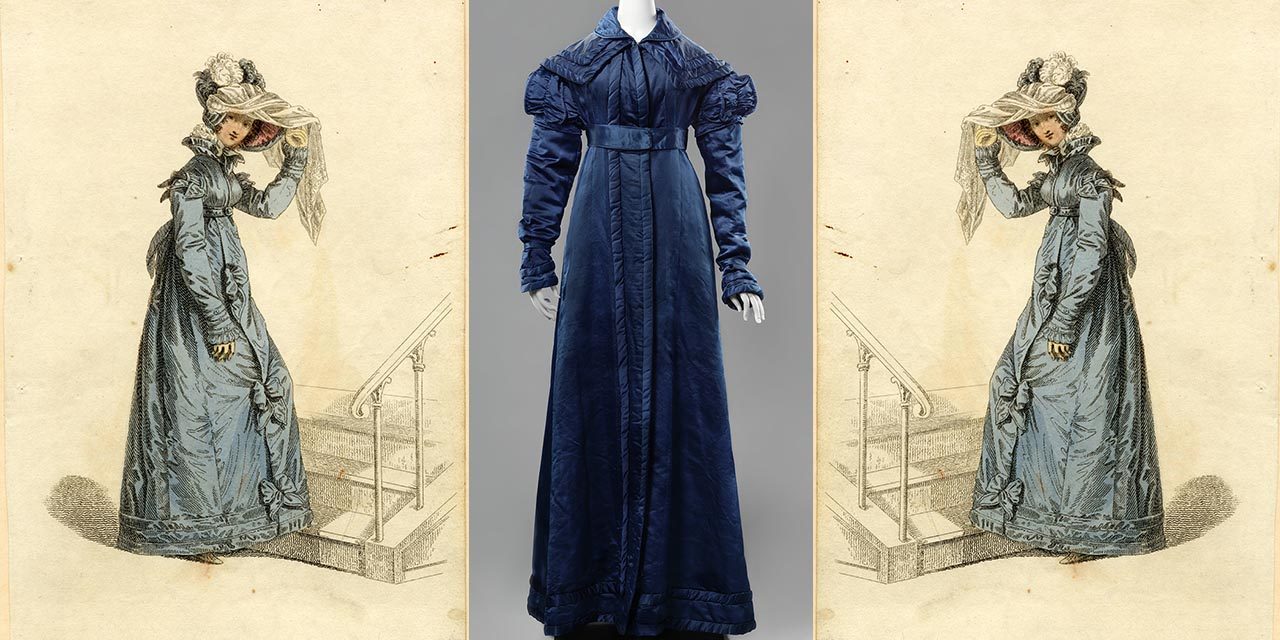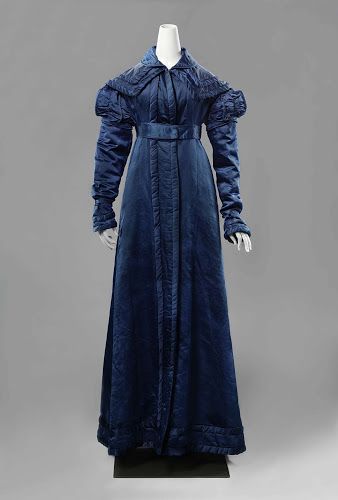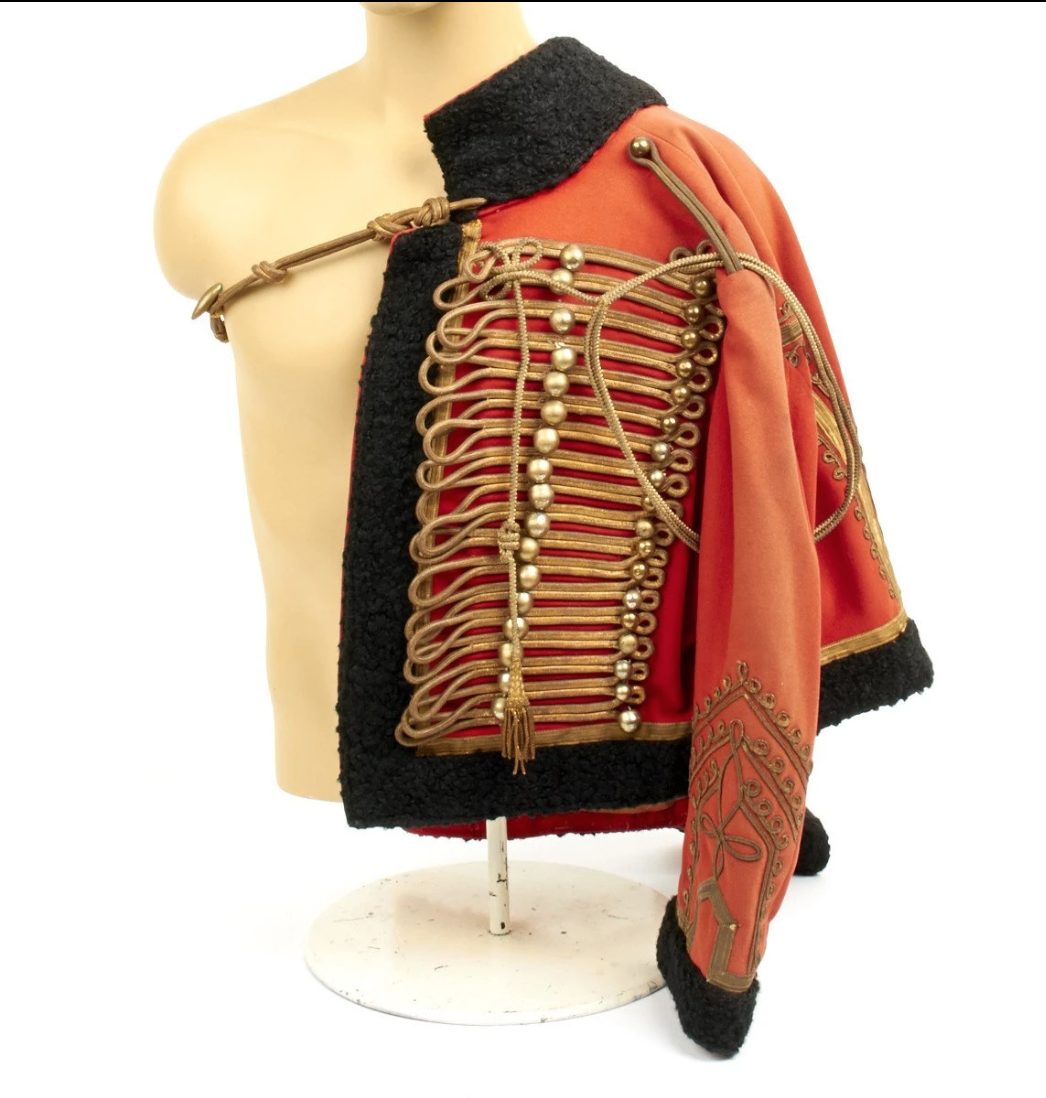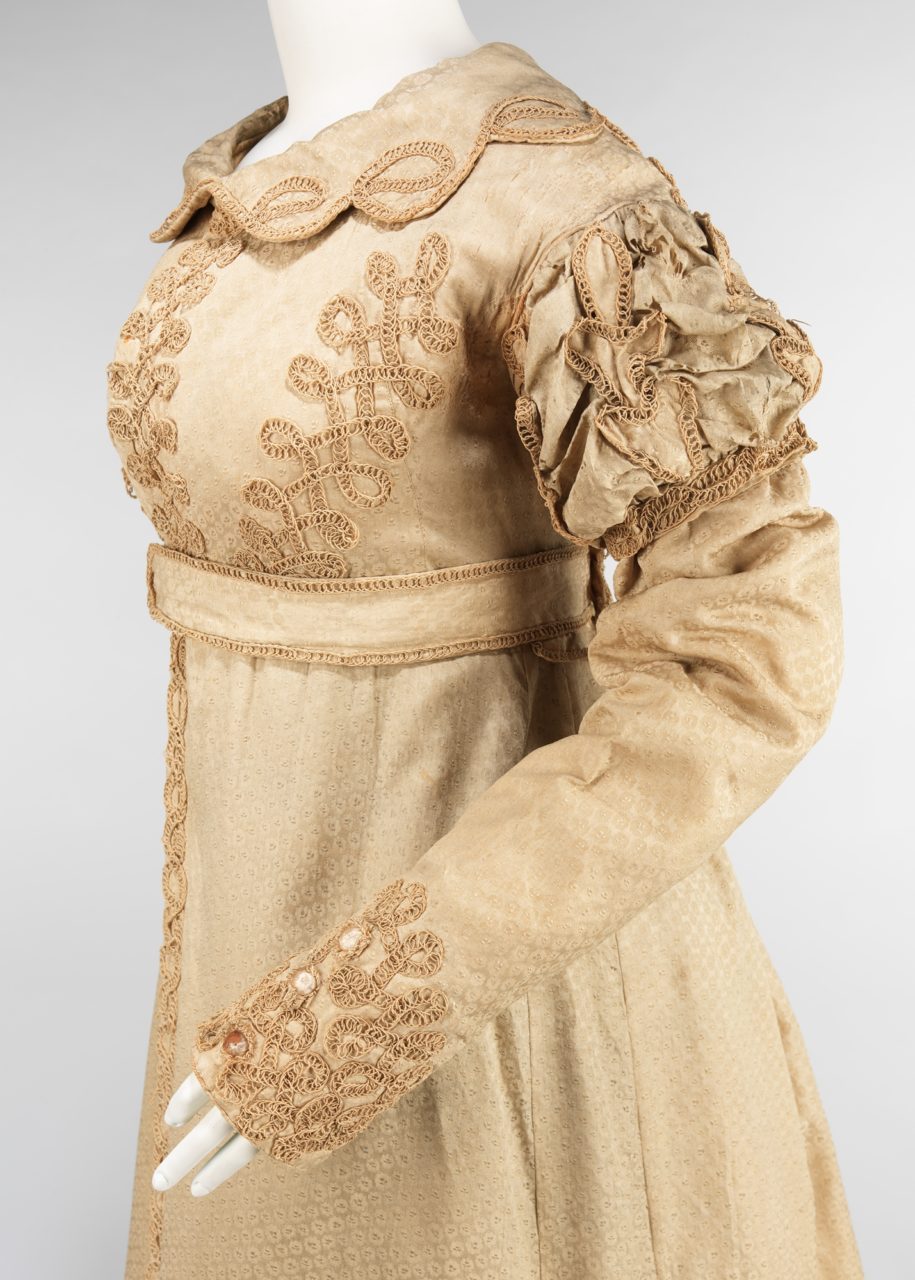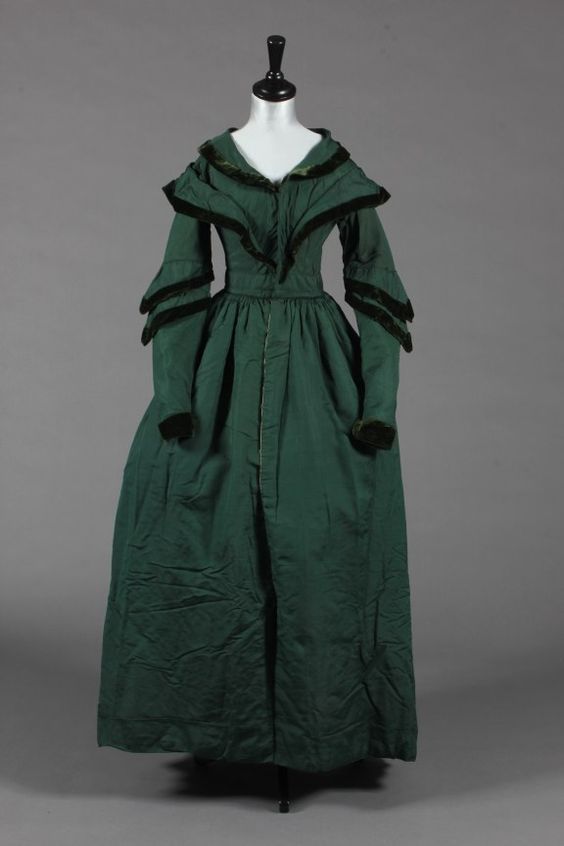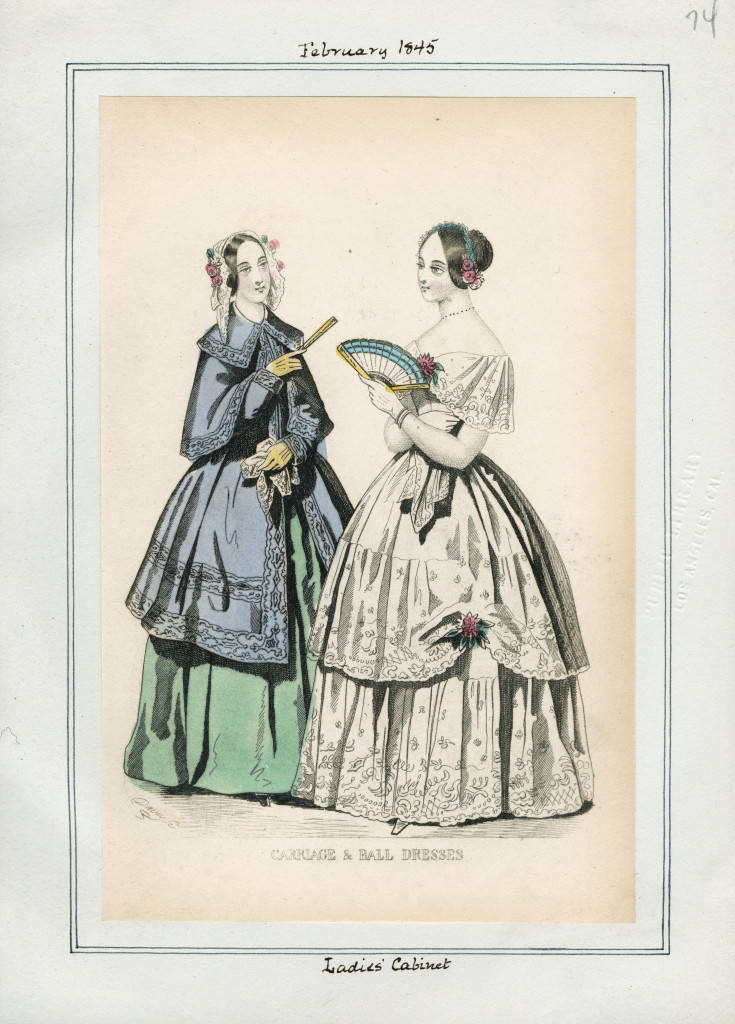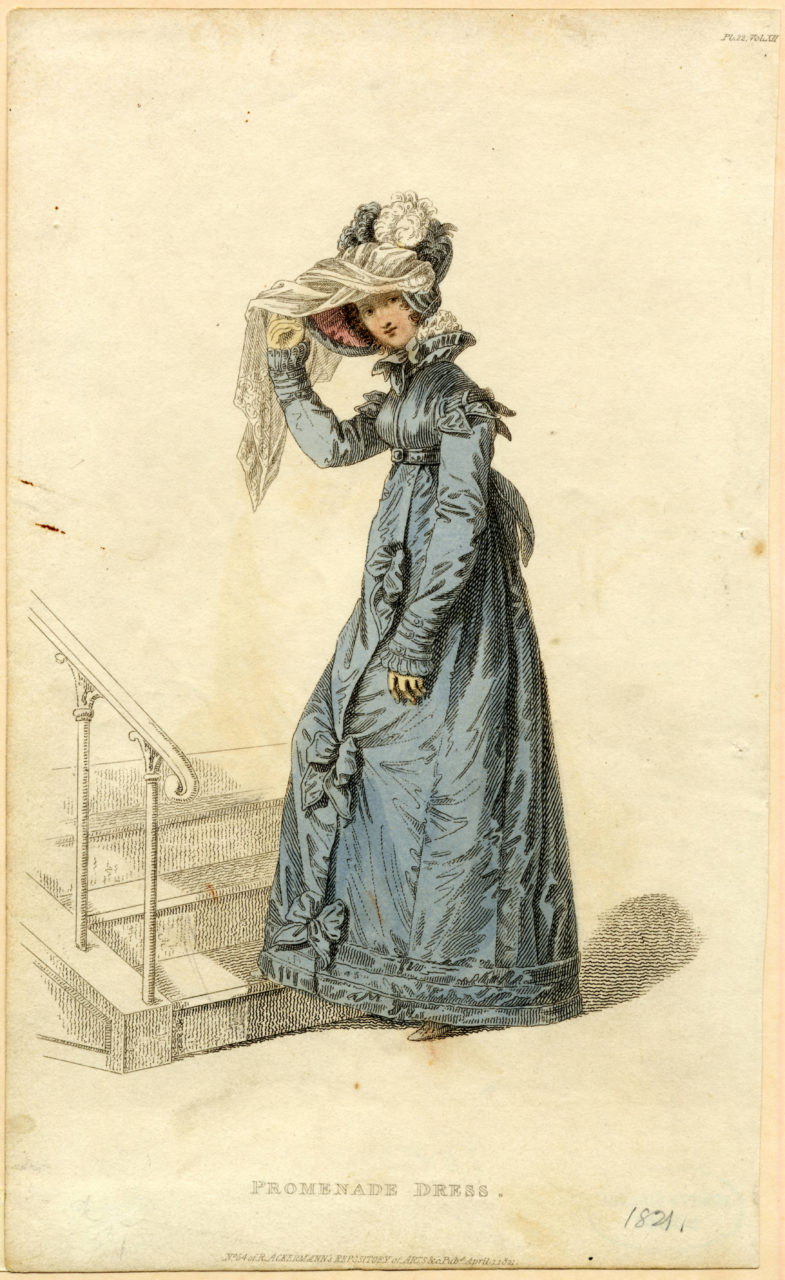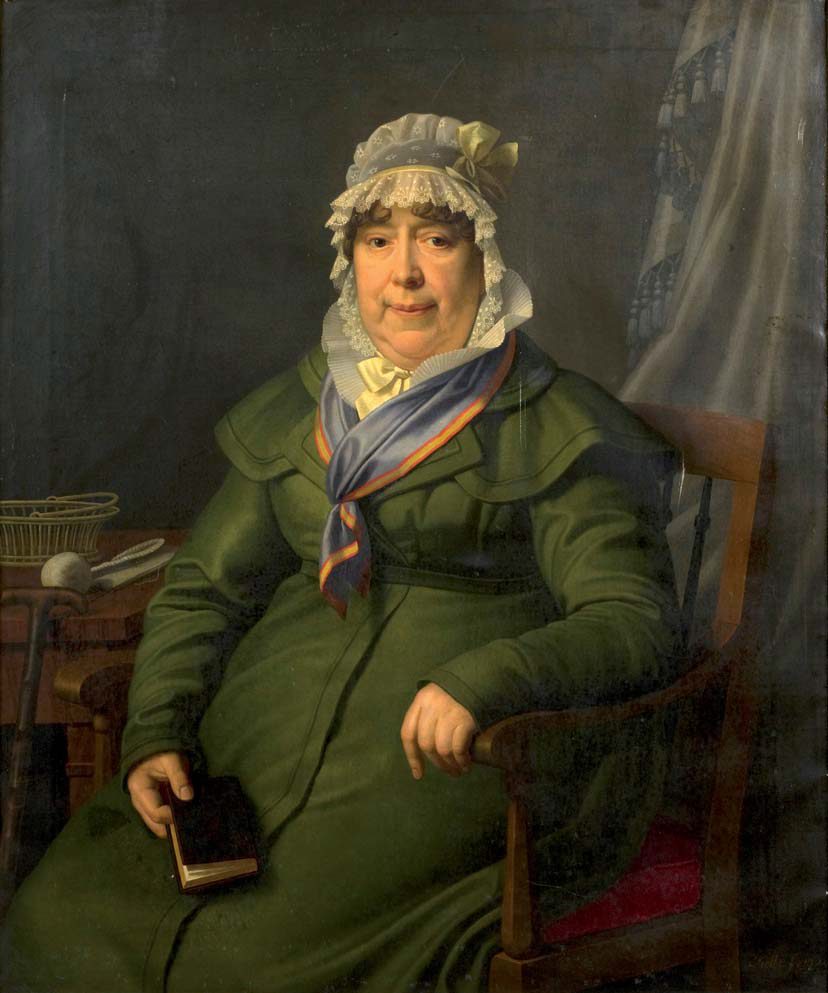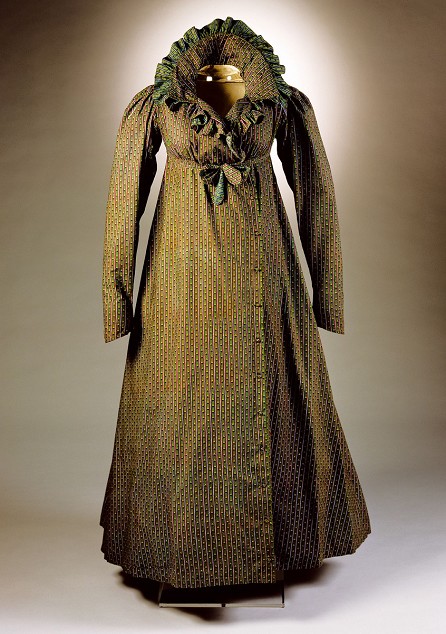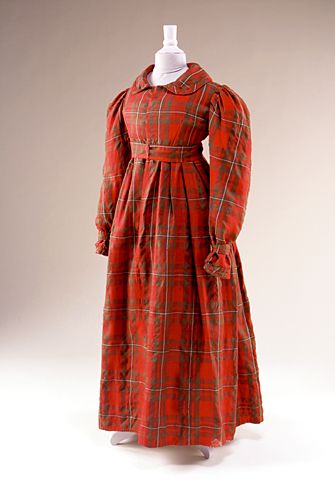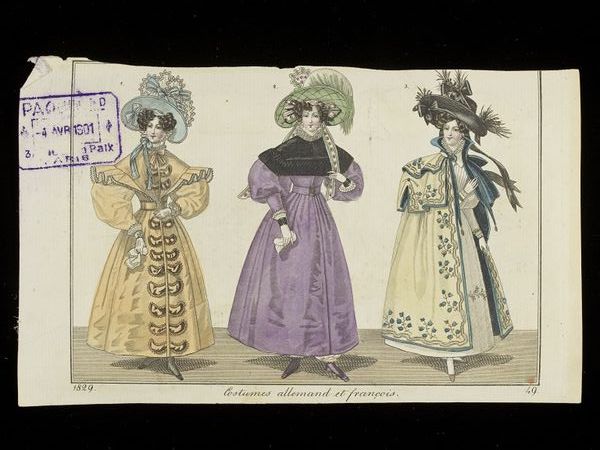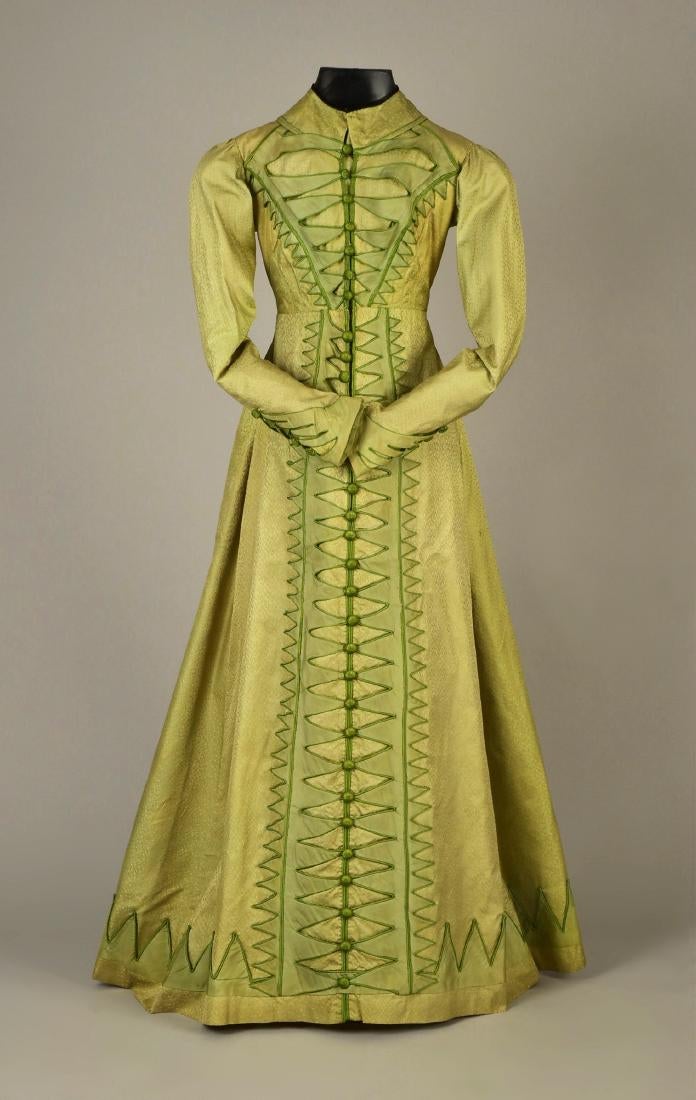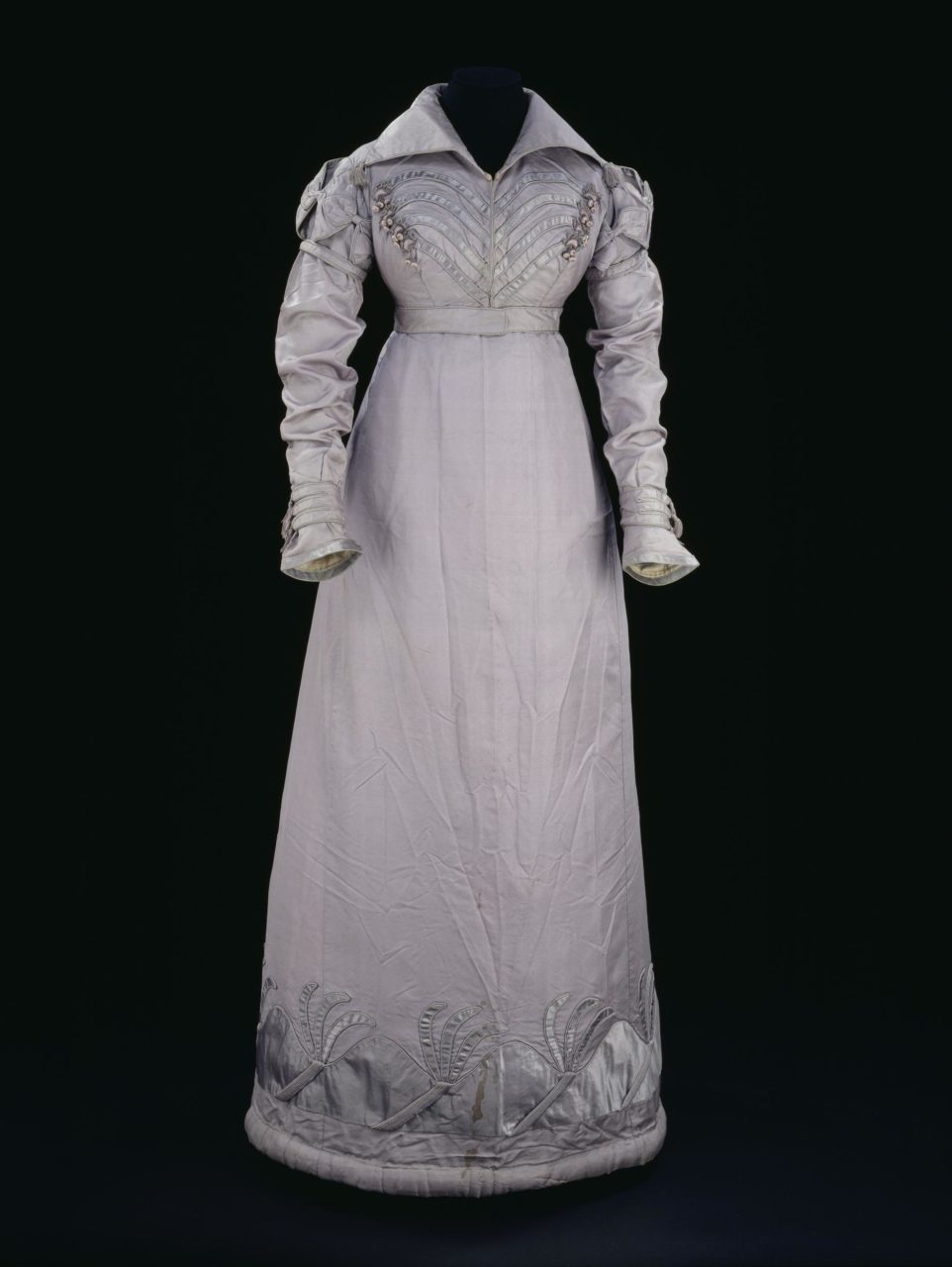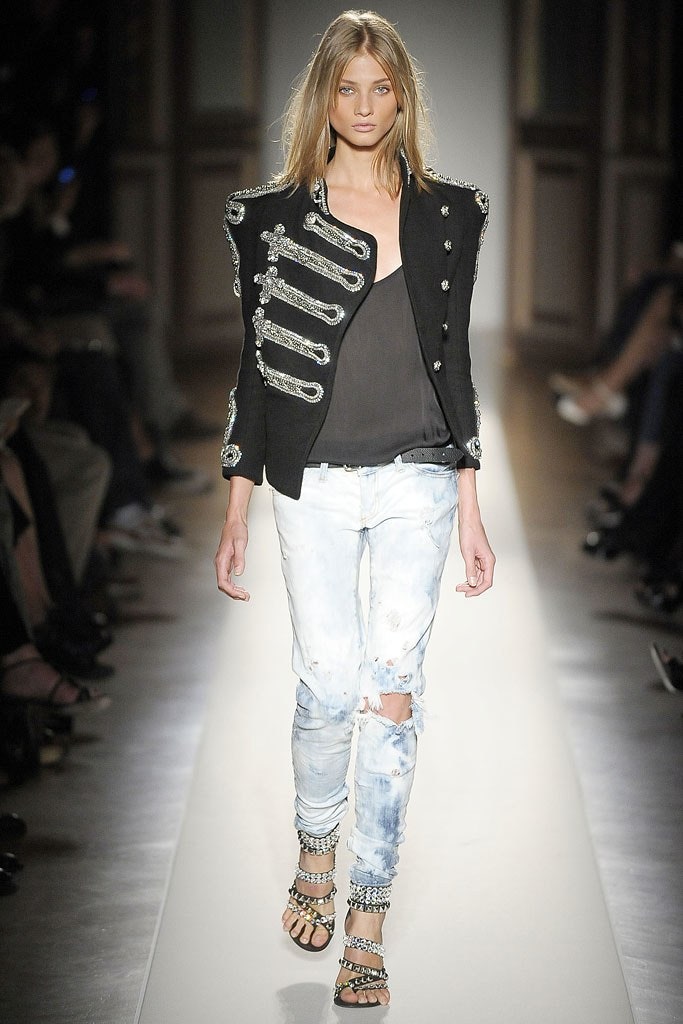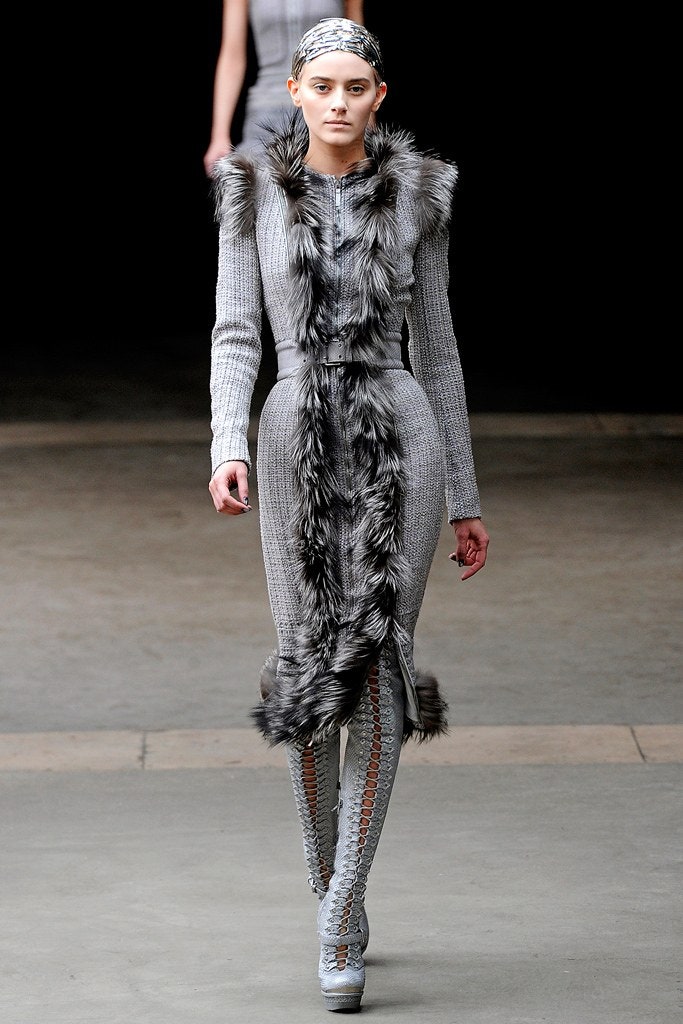A woman’s long coat with long sleeves and a front opening, used throughout the 19th century; can also refer to men’s military jackets and women’s sleeved mantles.
The Details
Kimberly Chrisman-Campbell described a “pelisse” in the Berg Encyclopedia of World Dress and Fashion: West Europe (2010) as:
“a long, front-fastening coat with long sleeves and the high waist of fashionable gowns—appeared at the end of the eighteenth century and remained fashionable until the mid-nineteenth century.”
Most commonly, the term ‘pelisse’ refers to this version of the garment, used at the beginning of the 19th century over gowns with a Neoclassical high waist and narrow skirts (Fig. 1).
However, an earlier usage of ‘pelisse’ from the 18th century referred instead to a sort of cloak (Fig. 2). Doreen Yarwood explains this in her Illustrated Encyclopedia of World Costume (2011):
“A woman’s mantle, usually fur-lined and fur-trimmed, worn during the eighteenth century; a re-introduction of the pelisson, the furred overgown of the Middle Ages. During the eighteenth century the pelisse had a large collar or shoulder cape and, sometimes, a hood. It could be of varied length from hips to ankles and had slits for the hands to pass through.” (318)
The term ‘pelisse’ has generally been used for women’s outerwear, but Chrisman-Campbell describes its origins in male military dress (Fig. 3):
“The term originally referred to a fur-trimmed cloak worn by hussar regiments, a type of light cavalry first deployed in Hungary. Hussar regiments from various countries’ armies figured prominently in the Napoléonic Wars. Thus, the pelisse united two contemporary fashion trends, military styling and exoticism, while striking a familiar silhouette. Although women’s pelisses were fitted and devoid of fur trim, they often revealed their martial origins with military-inspired decorative details like gold braid and frogging (looped braid fasteners).”
Indeed, many women’s pelisses bear lines of braid or rouleaux self-trim on the chests to mimic military lace or frogging (Fig. 4). Their sleeves, however, tended to be more imaginative, with all manner of shapes poking out of and entwined within a decorative cap sleeve over top of an extra-long main sleeve that often went partway down her hand.
Yarwood goes on to describe the nineteenth-century pelisse:
“The pelisse continued in fashion during the first forty years of the nineteenth century. In the early years it followed the high-waisted line, generally belted there. It was ankle-length and had long sleeves. With the wider skirts of the 1830s there was a return to the pelisse-mantle style, which hung loose to three-quarter length and had a waist-long cape which formed hanging open sleeves.” (318)
Pelisses changed shape to mimic the dresses they covered; compare the waistline, collar, sleeves, and skirt of figures 4 and 5, which were worn two decades apart. The re-introduction of a mantle into the garment is seen in figure 6, depicting a pelisse in 1845.
Yarwood goes to describe the end of the century:
“In the later nineteenth century a pelisse was worn by men; it was a long fur-lined coat with fur collar, cuffs and edging, favoured for winter use and chilly evenings.” (319)
Figure 7 shows a woman’s fur-lined pelisse in the same style from 1890, showing that the garment by this point had entered fashion for both men and women.
Fig. 1 - Designer unknown (Possibly Dutch). Gewatteerde jas, ca. 1820. Navy silk; 120.0 cm x 24.0 cm. Amsterdam: Rijksmuseum, BK-16000. Gift of A., Baroness van Harinxma thoe Slooten, Amsterdam. Source: Rijksmuseum
Fig. 2 - Pierre-Thomas LeClerc (French, about 1740–after 1799). Gallerie des Modes et Costumes Français. 19e. Cahier des Costumes Français, 13e Suite d'Habillemens à la mode en 1779. T.111, 1779. Hand-colored engraving on laid paper. Boston: Museum of Fine Arts, 44.1386. The Elizabeth Day McCormick Collection; Gift to the MFA, Boston, 1944. Source: MFA
Fig. 3 - Designer unknown (European). European Hussar Officer’s Pelisse, Early 19th century. Red wool, gilt rope, gold finish brass painted buttons, black wool fur trim. New Jersey, USA: International Military Antiques Inc., ON2929. Source: IMA
Fig. 4 - Designer unknown (probably American). Pelisse, ca. 1820. Silk. New York: The Metropolitan Museum of Art, 2009.300.629. Gift of the Brooklyn Museum, 2009; Gift of Annie M. Colson, 1929. Source: MMA
Fig. 5 - Designer unknown. A bottle green silk pelisse robe, ca. 1840. Green silk, velvet ribbon, lined in ivory silk, padded internally; bust 74cm (29 in). VT: Kerry Taylor Auctions, Lot 375, Feb 12th, 2013. Source: Kerry Taylor
Fig. 6 - Artist unknown (English). Carriage robe of green satin, with short pelisse of gray cashmere, Ladies' Cabinet v. 29, plate 74, February 1845. Fashion plate. Los Angeles Public Library, Volume2/rbc3436.jpg. Source: Tessa
Fig. 7 - Designer unknown. French Winter Pelisse, 1890. Print; 23 x 14 cm (9.25 x 5.5 in). The Miriam and Ira D. Wallach Division of Art, Prints and Photographs: Picture Collection, The New York Public Library, b17566471. Source: NYPL
The Metropolitan Museum of Art has at least a dozen pelisses from approximately 1800-1830, and describes them as:
“the quintessential women’s outerwear garment of the early 19th century. Due to the nature of the fashions of the time, the pelisse had to be very fitted and tailored to better cover the insubstantial textile of the gowns underneath…and tended to be very fashionable and follow the lines of Empire dress.” (Pelisse, ca. 1820)
The pelisse in figure 8 shows the very high waist and tight fit on the upper torso as well as how much of the body the pelisse covered. The painting in figure 9 of a wool pelisse demonstrates that women did wear the sleeves partway down their hands, and shows a masculine style inspiration – in its plainness and with the short cape, it resembles a greatcoat or carrick coat.
Daniel Delis Hill introduced the pelisse when discussing various types of outerwear in History of Western Costume and Fashion (2011):
“A similar overcoat of the time was the pelisse, which was cut fuller than the redingote and usually featured fur trim or lining.” (466)
What Hill fails to note was that the English pelisse and the French redingote were, in the early nineteenth century, the same garment. The word ‘pelisse’ (originally French) was used in England and America. In France, ‘redingote’ (originally English, from ‘riding coat’) was used. This can be confusing, especially because both words had other meanings in the eighteenth century.
Phyllis G. Tortora and Sara B. Marcketti describe the Regency (English) or Empire (French) pelisse in the Survey of Historic Costume (2015):
“The pelisse was similar to a modern coat that was full length and followed the typical Empire period silhouette. For winter, especially when made of silk or cotton, pelisse had warm linings. (316)
The pelisse in figure 10 is made of a printed cotton, and thus despite its dark color was probably not meant for the winter months. The example in figure 11 is made of wool, more sensible for winter weather. Few fur-lined pelisses actually survive in museum collections today.
The most heavily decorated and fashionable pelisses were made from silk, and had all manner of decoration (Fig. 12). A silk pelisse with velvet trim is visible in figure 13, with angular trim that nonetheless still echoes the officer’s military pelisse in figure 3. There are often, but not always, fasteners and trim that continue down the full length of the front opening.
The Met goes into fabric choice in another object entry:
“[T]he pelisse had evolved, by the turn of the century, into a long-sleeved, fitted coat, three-quarter to full length, which closely followed contemporary dress styles in shape and ornamentation. This later garment shows a wider range of fabrics and trimmings, often of contrasting colors. Depending on the season, the pelisse was made of cotton, silk, or wool and trimmed-usually on the collar, center front edges, cuffs, and hem-with fur, swansdown, lace, velvet, fringe, or silk plush.” (Pelisse, ca. 1815)
Some garments can be misleading. While it appears to be a pelisse, the purple ensemble in figure 14 is actually a short jacket, or spencer, over a matching dress. A sure way to distinguish if a garment is a pelisse is to note its opening; since the center front closure on the chest here does not extend down the rest of the skirt, it must not be a full coat. Spencers are effectively shortened pelisses that end at the waist, and bear much of the same decoration and styling.
Another confusing garment can be seen in figure 15: This green ensemble looks like a pelisse but is actually a riding habit. Riding habits – dresses made specifically for equestriennes – are also similar in appearance to pelisses, but have impractically long skirts (for riding sidesaddle) and simpler decorations. They are also usually a solid-colored wool rather than a silk or patterned cotton.
Fig. 8 - Artist unknown (English). Promenade dress, Ackermann's Repository, Spring 1821. Fashion plate; (5.75 x 9.25 in). Claremont, CA: Scripps College, Ella Strong Denison Library, Macpherson Collection, Costume Plates of Myrtle Tyrrell Kirby, box 3, fpc00121.tif. Source: CCDL
Fig. 9 - Heinrich Christoph Kolbe (German, 1771–1836). Sara Esther Merrem Siebel, 1824. Oil on canvas; 104 cm x 85 cm (40.9 x 33.4 in). Wuppertal, Germany: Historisches Zentrum Wuppertal. Source: Wikimedia Commons
Fig. 10 - Designer unknown (probably German). Coat dress, ca. 1815. Printed cotton; top: vl: 26.5 cm, hl: 25 cm; skirt: vl: 108 cm, hl: 112 cm; total length: 135 cm. Cologne: Köelnisches Stadtmuseum, KSM 1971/265 = T 627. Gift of Karl Friedrich Band, 1971. Source: KSM
Fig. 11 - Designer unknown (American (textile British)). Pelisse, ca. 1825. Red, green and white twill weave wool (macgregor tartan), bleached plain weave cotton lining, brass; overall: 132.715 cm (52.25 in). Deerfield, MA: Historic Deerfield, HD 2003.30. Museum Collections Fund. Source: FCHDMC
Fig. 12 - Artist unknown (French). Three women in day dresses, pelisse robes and a cloak. Costumes Allemands et Francois, 1829. Engraving, hand-coloring. London: Victoria and Albert Museum, E.22396:175-1957. Given by the House of Worth. Source: VAM
Fig. 13 - Designer unknown. Nile green figured silk pelisse, 1815. Green silk, white silk lining, black velvet trim, faux dorset buttons; (b-30, w-21, l-53 in). Charles A. Whitaker Auction Co., Lot 0099, April 28, 2018. Source: Liveauctioneers
Fig. 14 - Designer unknown (English). Dress, 1817-20. Silk, applied with silk satin panels, trimmed with passementerie, lined with cotton, metal. London: Victoria and Albert Museum, T.110 to B-1969. Given by Mrs A. Wallinger. Source: VAM
Fig. 15 - Designer unknown (Possibly Dutch). Riding habit, ca. 1826. Wool, silk, cotton; 120 cm × 132 cm × 54 cm × 60.5 cm × 26.5 cm x 2.4 cm. Amsterdam: Rijksmuseum, BK-VII-N. Source: Rijksmuseum
Its Afterlife
Long-sleeved and skirted coats are also popular for figure-hugging silhouttes even today. The Alexander McQueen Fall 2011 runway featured several fitted coats with fur trim or lining, including the grey fox fur example in figure 17.
Fig. 16 - Christophe Decarnin for Balmain (French, 1964-present). Look 1, Spring 2009 RTW. Model: Anna Selezneva; Photo: Marcio Medeira. Source: Vogue
Fig. 17 - Sarah Burton for Alexander McQueen (English, 1974-present). Look 5, Fall 2011 RTW. Wool, nylon, viscose, cotton, silk, leather blend; fox fur, silk lining. Model: Kori Richardson; Photo: Yannis Vlamos. Source: Vogue
References:
- Chrisman-Campbell, Kimberly. “France.” In Berg Encyclopedia of World Dress and Fashion: West Europe, edited by Lise Skov, 179–192. Oxford: Berg, 2010. Accessed March 22, 2020. http://dx.doi.org/10.2752/BEWDF/EDch8036a
- Hill, Daniel Delis. History of World Costume and Fashion. Upper Saddle River, N.J: Pearson Prentice Hall, 2011. http://www.worldcat.org/oclc/939043732
- “Pelisse, ca. 1820.” The Metropolitan Museum of Art. Accessed 13 March 2020. https://www.metmuseum.org/art/collection/search/159181
- “Pelisse, ca. 1815.” The Metropolitan Museum of Art. Accessed 21 March 2020. https://www.metmuseum.org/art/collection/search/82141
- Tortora, Phyllis G., and Sara B. Marcketti. Survey of Historic Costume. Sixth edition. New York: Fairchild Books, 2015. http://www.worldcat.org/oclc/910929404
- Yarwood, Doreen. Illustrated Encyclopedia of World Costume. Mineola, NY: Dover Publications Inc., http://www.worldcat.org/oclc/764559141

